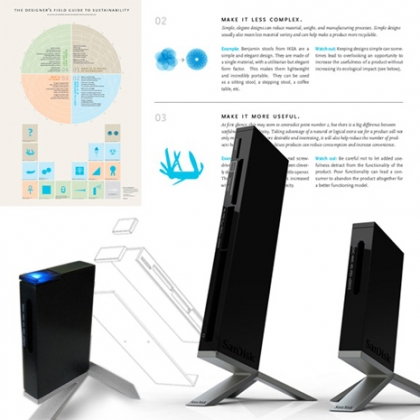Co-Author: Travis Lee – It’s not uncommon that I’m asked the simple question “what exactly is product design?” It’s a fair enough inquiry – removing yourself from the product development process just long enough to surface for air, you might realize that it’s extremely unusual for the average human to have even a basic understanding of how a product ends up on the retail shelf. My answers vary on the context, but quite often I find myself using the ‘architecture’ analogy:
Products, like buildings, grow from the collaborative exchange of ideas between a designer and engineer as they arrive at a resolution that both looks great and actually works.
There exists a level of familiarity with the face of the architect that resonates with people. And as more architects begin to speak the language of ‘green-building’ more well-rounded designers and engineers are beginning to speak the language of ‘green design.’ Of course, the very phrase begs the question “what is green design?” We could simply say “Green design is like green building: the act of creating a physical element with as little environmental and social damage as possible.” Or, more memorably, we could quickly walk you through an average product design process here at LUNAR.
Employing the virtues outlined in LUNAR’s “Designers Field Guide” we identified 15 discreet activities in the design and engineering process. A LUNAR Elements Case Study of the next generation of Sandisk ImageMate card-readers helps illustrate our typical approach to best environmental practices. Here are some of our favorites (please feel free to reference the Designer’s Field Guide to Sustainability document for a more complete analysis):
1. Question the premise of the design. LUNAR began the ideation phase by deconstructing the intent of the product, ultimately arriving at the simplified architecture as a metaphor for reducing the esthetic and physical complexity of a highly visible desktop computer component. We reduced total part count to four!
5. Avoid toxic or harmful materials and chemicals. We eliminated paint on the plastic enclosures in favor of molded-in color. We also eliminated the need for an extra process to apply the logo by molding it into the plastic enclosures. We finished the zinc base with a bead-blast in lieu of the highly common chrome finish.
6. Reduce size and weight. LUNAR minimized the enclosure volume and made the product as thin and light as possible by revisiting the internal layout and conceptualizing a better architecture.
12. Make it modular. The base of the product is modular and it can be used for multiple products in the ImageMate line.
13. Use recyclable materials. ABS enclosures are recyclable, and all the parts can be separated for ease of material disposal.
14. Minimize fasteners. No fasteners are used in these products. The plastic enclosures are ultrasonically welded and the rest of the parts (magnets, label and rubber feet) are glued.
15. Do not use paint. Paint was not required for any of the plastic components.
The Elements Case Study process highlights some of the decisions that were made during each product’s development in an effort to better understand those initiatives that have can have a positive environmental effect. If even an incremental difference, the result for LUNAR is a thoughtfully conceived, more gorgeous product language that exudes our own values and beliefs.
Please visit Sandisk.com for more info on the LUNAR- designed ImageMate family.

